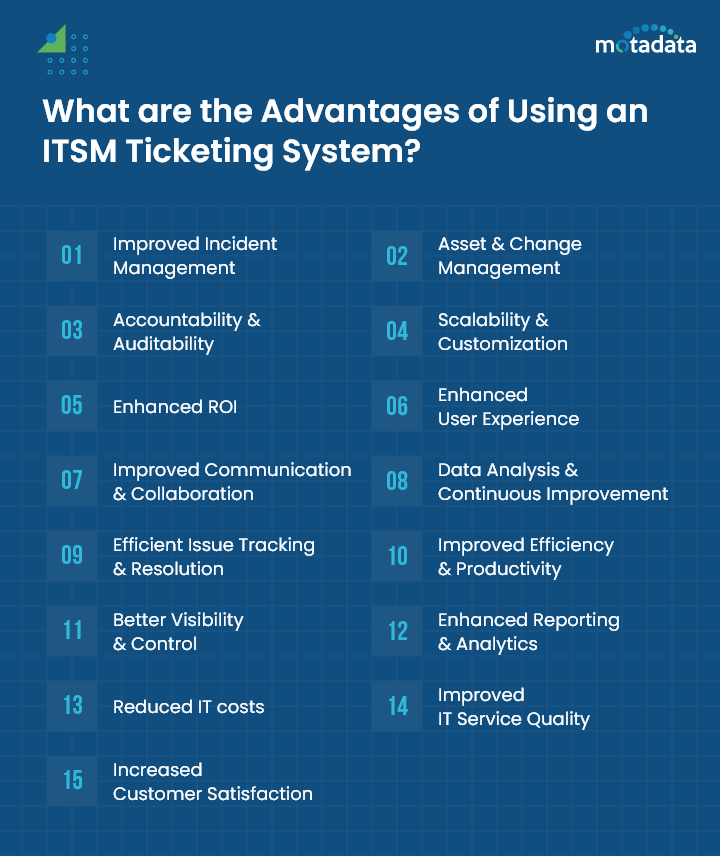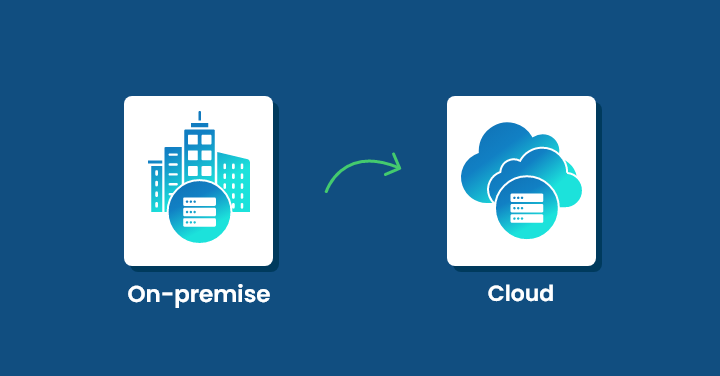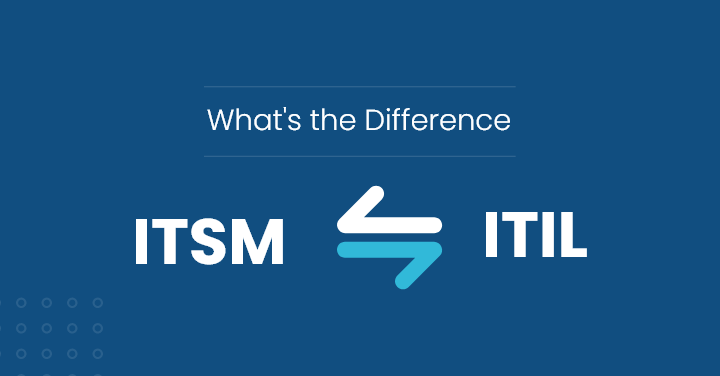In the year 2020, a large percentage of businesses and job sectors moved to remote working due to the COVID-19 pandemic. Even when things turned a bit normal, still 63% of businesses chose to continue remote working.
Even today, 40-50% of businesses work remotely. Remote working and e-commerce businesses have grown tremendously in the past few years.
In such a case, managing customer satisfaction is of utmost importance.
Hence, having a service desk that is effective and productive in handling client interactions, whether they are existing or potential is crucial.
It all might sound like a simple task but with the increasing complexity of IT systems, managing incidents, changes, and other tasks without a proper system is quite difficult.
This is where the mechanism of IT Service Management (ITSM) as a client relationship management tool comes in.
ITSM Ticketing Systems simplifies the way in which businesses handle IT-related problems and service requests.
It looks into the user’s log tickets detailing their concerns, tracks the status, and provides recommendations.
Thus, ensuring streamlined workflows, effective communication, and problem-solving.
Let us learn more about the ITSM Ticketing System’s benefits, key components, and its importance in modern businesses.
Further, we will highlight factors to consider when choosing ITSM tools.
Importance of ITSM Ticketing Systems in Modern Businesses
The IT service management ticketing system is a vital tool for modern enterprises looking to streamline operations.
Effective service delivery is facilitated by its role as a single point of contact for handling client requests and incidents.
By using this approach, you can guarantee accountability, and improve customer experience and communication all at once.
Ultimately, it contributes to employee satisfaction and overall corporate success by offering useful information for decision-making and ongoing improvement.
What is ITSM?
ITSM is a process that enables the IT department to supervise the full range of services that are provided to clients via information technology. It includes organizing, creating, implementing, and maintaining IT services.
The overall objective of putting this approach into place was to assist organizational growth by aligning IT services and procedures with business objectives.
However, this approach is commonly driven by frameworks like the Information Technology Infrastructure Library (ITIL).
What is an ITSM Ticketing System?
An ITSM Ticketing System is a central hub where all the IT incidents and service requests reported by users are logged, monitored, and resolved.
It is a key component of ITSM used by IT teams for quickly resolving IT issues.
It makes it easier to prioritize issues and allocate them to the right IT staff so they may be resolved in real time with the least amount of service interruption.
What are the Advantages of Using an ITSM Ticketing System?
Apart from providing quick resolution to IT issues, there are various advantages of using an ITSM Ticketing System, including:
1. Improved Incident Management
By working on the incident management part, businesses can enhance their operational efficiency and ensure user satisfaction.
Organizations can perform root cause analysis by streamlining incident tickets and improving the resolution process as a whole through process optimization.
Better incident ticket management and, eventually, more effective incident resolution are made possible by the integration of ITSM ticketing systems.
2. Asset and Change Management
Another advantage of using these tools is they help streamline the IT asset management processes that further results in improved business operations. The process is efficiently managed since change requests are integrated with ease.
Further, it facilitates prompt and effective customer support in addition to the option for automatic status updates to be cascaded to child tickets.
3. Accountability and Auditability
It facilitates the execution of audit procedures and serves as a single point of contact for a variety of accountability activities.
Furthermore, by offering a unified platform for organizing and monitoring all audit-related tasks, the ITSM software improves accountability.
Its strong reporting and analytics capabilities, which are crucial for proving compliance and transparency, also help to achieve auditability.
4. Scalability and Customization
These tools are essential for helping companies grow their services and provide specialized solutions that meet their unique requirements.
The increased flexibility and adaptability that IT service management ticketing solutions clearly demonstrate the benefits of scalability.
Furthermore, these systems also guarantee that companies can effectively address the specific needs of their internal operations and clients thanks to their customization features.
5. Enhanced ROI
By putting in place an ITSM ticketing system, IT investments can be precisely tracked and managed, which reduces costs and improves resource allocation.
With the help of this advanced solution, businesses can maximize the value of their IT infrastructure and services by precisely calculating the return on their investments.
Moreover, this implementation contributes to improved ROI and overall organizational success by helping to illustrate the business value of IT services.
6. Enhanced User Experience
The ticketing system provides quick support and IT resolutions to users, leading to satisfied customers and a better user experience.
By streamlining user inquiries, the system guarantees prompt resolution and high-quality service. Thus, enhances the overall user experience and engagement rate.
7. Improved Communication and Collaboration
An ITSM ticketing system guarantees effective incident and service request management, which promotes teamwork and enhanced coordination by facilitating smooth communication and collaboration within the IT department.
Enhancing teamwork and knowledge sharing promotes accountability and openness in IT operations.
Employee happiness and productivity are eventually raised by the ITSM software, which improves communication and collaboration by offering a single point of contact for IT service requests.
8. Data Analysis and Continuous Improvement
With the help of this robust software, IT departments can easily identify the trends and areas of improvement that enable proactive problem management.
Organizations employ data analysis to find the core causes of problems, develop preventative measures, and improve decision-making through continuous service improvement.
9. Efficient Issue Tracking and Resolution
It becomes easier to keep an organized log of problem-solving activities, which lowers downtime and boosts service availability.
This is essential for sustaining high employee satisfaction levels and guaranteeing continuous service delivery.
As a result, IT service management can be greatly improved by putting in place an ITSM ticketing system.
10. Improved efficiency and productivity
This software also facilitates the automation of workflows and repetitive tasks, improving resource efficiency and standardizing service delivery.
IT support staff benefit from faster response times and more productivity as a result of this.
By utilizing natural language processing (NLP) phrases like “help desk software,” “management platform,” and “information technology,” the ITSM ticketing system functions as a centralized point of contact for effective IT service management, yielding significant advantages for businesses.
11. Better visibility and control
With the help of this ticketing system, organizations can gain in-depth insights into the status of IT service requests in real time.
With these insights, team members can improve their IT operations and maintain centralized control over all activities.
Moreover, it promotes accountability and transparency in the provision of IT services by aiding in the enforcement of compliance standards and service-level agreements.
12. Enhanced reporting and analytics
Resolving issues, volume of tickets, response times, and other ITSM and individual performance indicators are all reported on using ticket data.
Further, ticket data analysis facilitates the discovery of patterns, areas for enhancement, and the best use of available resources.
In short, users can gain detailed reports on key performance indicators and service performance that further aid in service optimization and better decision-making.
These insights can also be monitored with graphs and charts supported by reports, making it easier to understand all the processes and details.
13. Reduced IT costs
By optimizing incidents in real time and reducing the impact of downtime and service disruption, businesses can save on their unnecessary expenses and recovery costs.
Further, the ticketing system’s installation promotes resource efficiency and cost-effective IT service management.
14. Improved IT service quality
By improving the consistency of IT support and service delivery, an ITSM ticketing system guarantees increased responsiveness and dependability in IT operations.
By coordinating IT services with business objectives and user requirements, organizations preserve service excellence and customer satisfaction.
15. Increased customer satisfaction
The solution facilitates the prompt response to support requests, which leads to increased customer satisfaction.
The process is streamlined by automatically creating and forwarding tickets, which enhances incident ticket management and user experience.
Customer satisfaction is increased via effective ticket management, and more improvement is achieved through root cause analysis.
How to Choose an ITSM Ticketing System
When choosing an ITSM ticketing system, it is important to consider the following factors:
The size and complexity of your IT organization
Make sure to check that the selected ITSM ticketing system is capable of handling a large volume of service requests that often happen in large and complex IT environments.
Advanced features are essential in these tools to manage such requests for efficient incident management. Also, ensure that the system is scalable and capable to meet the growing needs of business.
Your budget
It’s critical to consider an ITSM ticketing system’s cost-effectiveness in light of its capacity for service management.
Seek a solution that fits inside your budgetary limits and optimizes agent productivity.
The program should maximize the productivity of the IT support team members while staying within budgetary constraints and offering value for money without sacrificing service delivery.
There are several tools available in the market that offer excellent features at affordable pricing. Compare different IT ticketing software and choose the one that meets your budget requirements.
Your specific needs
It is important to prioritize your individual demands while choosing an ITSM ticketing system.
The solution should support your specific needs by providing customizable SLA management that complies with your request, modification, and incident management procedures.
In order to properly meet the unique needs of your firm, it should also effectively address your asset management needs.
You may streamline your IT service management processes and raise overall effectiveness by selecting a solution that takes these particular factors into account.
Examples of ITSM ticketing systems
Example 1:
Consider you run a multinational corporation with multiple branches across the nation and rely on your IT infrastructure to run daily operations.
Now, in such a case what if one of your critical applications used by the finance department becomes unavailable?
Well! If the issue is not resolved in real time, it may impact your operations and customer experience.
However, with a robust ITSM ticketing system in place, your team can manage the following incident in real-time, assign the ticket generated to the appropriate support team on a priority basis, and remediate the issue.
Further, the system will automatically send notifications to stakeholders to identify any changes or developments made to the current setting.
Thus, making it easier to resolve incidents faster even in complex IT environments.
Example 2:
Imagine you work in a private hospital that supports vital operations with hundreds of medical staff members, several departments, and different IT systems.
Every IT outage or technical problem has the potential to negatively affect patient care and safety in such a complex environment.
To reduce these risks and guarantee smooth IT service delivery, the healthcare facility put in place an ITSM ticketing system designed specifically for the medical field.
As a result, Clinical staff, IT support teams, and other stakeholders can communicate with each other centrally using this ITSM ticketing system.
By being proactive, this communication will reduce misunderstandings and guarantee that all parties are aware of the state of IT services.
Further, the ITSM ticketing system records all IT-related events, modifications, and resolutions, which aids the hospital in staying in compliance.
In addition to making regulatory audits easier, this documentation offers insightful information that helps IT service delivery procedures be continuously improved.
Case study
About Emirates Healthcare
Emirates Healthcare, part of the Emirates Hospital Group, is a leading healthcare provider in the UAE. They offer a wide range of services across hospitals, urgent care units, specialty clinics, cosmetic clinics, and pharmacies.
Challenges
Emirates Healthcare needed a robust ITSM solution to address several key challenges:
Location-based Ticketing: They required a system to categorize tickets based on their originating facility for efficient troubleshooting.
Modern Email Integration: Outdated email support needed an upgrade to integrate seamlessly with their latest Microsoft Exchange servers.
Automated Workflows: Streamlining ticket routing and auto-closing resolved tickets would improve efficiency and reduce technician workload.
Comprehensive Asset Management: Network scanning using WMI and SSH protocols was essential to populate their CMDB with accurate asset details.
Offline Asset Tracking: Barcode support was crucial for tracking IT assets even without an internet connection.
Solutions
Motadata’s ITSM solution addressed all of Emirates Healthcare’s challenges:
ITIL-compliant Helpdesk: A unified platform ensured smooth operations aligned with best practices.
Seamless Email Integration: The “Email to Ticket” feature provided hassle-free email support.
Multi-level Categorization: Tickets were categorized based on location and other relevant criteria for efficient routing.
Smart Workflow Automation: Automated workflows facilitated auto-routing, closing resolved tickets, and streamlined overall operations.
Secure Web Server Connection: HTTPS ensured secure communication between browsers and the web server.
Barcode Scan Support: Offline asset tracking became possible with barcode scanning capabilities.
Network Scanning with WMI and SSH: Comprehensive asset details were automatically populated in the CMDB using these protocols.
Quote from the Client:
Key Stats:
- Assets Managed: 1200
- Technician Licenses: 20
Results
Motadata’s ITSM solution empowered Emirates Healthcare with:
- Streamlined IT operations through smart automation
- Efficient handling of network-related tickets across multiple locations
- Improved technician productivity
- Enhanced overall IT service delivery
FAQs
ITSM ticketing systems give users a central area to submit requests, which are then managed by IT support teams. These tools streamline issue resolution procedures, notify users of developments, and automate request handling processes.
ITSM ticketing systems offer a consolidated platform for collaboration, which improves communication within an organization’s IT department. IT workers can work together to resolve issues while users submit tickets and receive real-time updates.
Additionally, the ticketing system makes it possible to thoroughly document problems and their fixes, which enhances knowledge management.
These systems capture and analyze events, service requests, and problem management data to find trends and patterns that can be used to improve service delivery.
Analytics also assist in budgeting and resource allocation by pointing out inefficiencies and bottlenecks. Using these data and analytical insights, businesses are able to make better decisions.
Yes, organizations may tailor ITSM ticketing systems to meet their unique requirements because of their high degree of flexibility and scalability. For greater productivity, these systems can be linked with other applications and adjusted to match existing processes. These systems are easily adaptable to changes as businesses expand and change.







